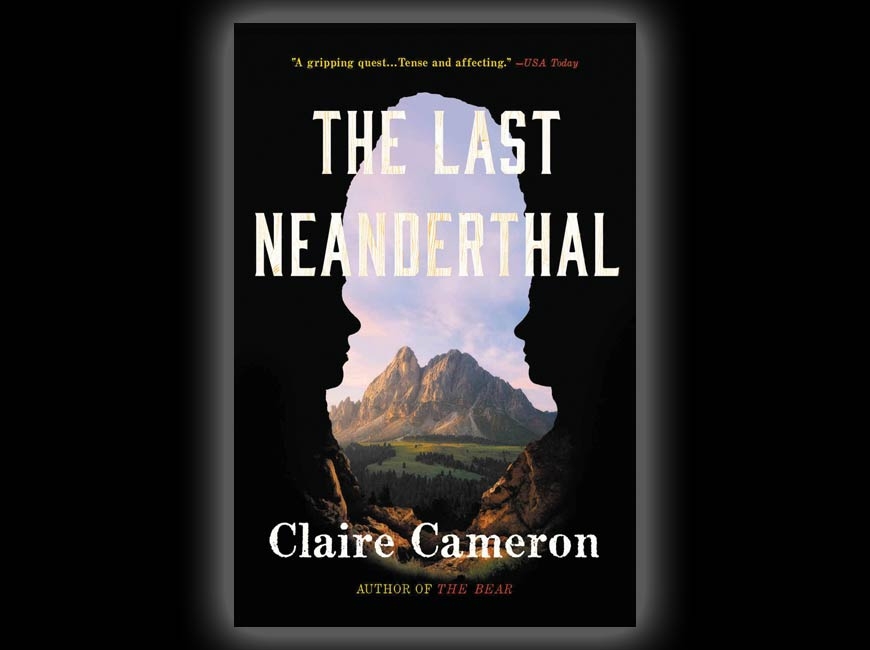In Cameron’s novel, at the very outset, the undiscovered is discovered and gives way to the unexpected and a possible explanation for who we are and how we got this way. Cameron’s main contemporary character, archeologist Rosamund Gale, while excavating at a dig in France, discovers the skeletons of a male homo sapien and a female Neanderthal lying side by side and facing one another, like lovers, in a private section of a grotto known to have been inhabited by Neanderthals. Knowing of the theory that homo sapiens and Neanderthals probably, in some cases, were sexual partners and that recent DNA testing gives evidence to this idea, Rosa believes that she has discovered one of the substantial missing links in our human lineage and that we are, indeed, the sum of our parts.
But this is only half of the story. The other half takes us back 50,000 years to the time and the family from which the female Neanderthal (named GIRL in the novel) lived, and we experience in great descriptive detail the day to day activities of some of our most ancient ancestors.
Cameron’s theory, which is being confirmed with each passing year in the scientific community, is that Neanderthals are anything but the dumb apes that they have been portrayed to be in popular media, but rather creative, intelligent hominids with sensory powers that we have long lost via the social and technological “advances” of the past several thousand years. The Neanderthals in Cameron’s book are knowledgeable and sensitive to their surroundings and able to survive simply and sustainably without destroying their bioregions or ecosystems. That’s something that modern-day hominids certainly cannot claim.
Our story in The Last Neanderthal takes place in two extreme epochs: one occurring 50,000 years ago at the approximate time of the extinction of the Neanderthal lineage; and one occurring in the present day. In the first epoch we experience what Neanderthal life was probably like on a day-to-day basis for the last Family (with names such as Big Mother, Him, Bent, Runt, Sister and Fat Boy) of the species as it very quickly is depleted to but a single family member, GIRL. In the second epoch we are with archeologist Rosamund Gale (known to friends and colleagues as Rose) on her archeological dig in France where she discovers the bones of an integrated pair of “lovers” coming from both sides of the evolutionary tree and her efforts and struggles to establish this bit of evidence as scientific fact and to gain credibility with a skeptical institutional bureaucracy in order to add to our expanded knowledge of the history of humans.
On page 3, speaking of Neanderthals, she states:
Related Items
“It’s because of their similarities to us that I can speak for them when I say that much of what you’ve heard isn’t true. They were kind and clever. Their brains were larger than ours by about 10 percent. Many of us have inherited up to 4 percent of their DNA, and we know that their genomes differed from ours by only about 0.12 percent. By curling up the top lip, they could feel the heat of a body from a mile away. Their ears could pinpoint where a drop of water had fallen in a pond long after the ripples were gone. Their eyes could see the unique pattern of bark on each tree and this allowed them to tell one from the next, just as we can with human faces.”
Then on page 184 she continues her description of Neanderthal physical acumen and awareness.
“The clouds overhead gave a rumble. It wasn’t thunder but a small pulse that she could feel on the skin under her lip. She gave the air a sniff. Soon the weather would turn. Lifting a wet foot, leaning more on her spear, she closed her eyes. With the fine bones of her foot, she could feel that the pressure in the air was dropping. The winter storms were a way off, but the first hints of them had already arrived.”
While most of The Last Neanderthal deals with these kinds of particulars and the struggles for personal and professional survival by both of our heroines, the questions of brilliance and equanimity of the Neanderthal race remains at the heart of this novel, highlighted by GIRL’s first sighting of a homo sapien.
“A small movement caught her eye — the twitch of a branch. It rattled just slightly and she knew something was there, high on the rocky perch above the river. From where she was she was able to define the shape. It watched them. The shape of the body was long and thin. It was upright with tight hides over its skin and was smaller with a round head and dark hair.”
From here and at the end of the book, we’re transported to the present day with Rose in the dirt at the dig where she is dusting off the bones of the female Neanderthal and looking directly into her eye sockets and thinking, “We are so much the same.”
Thomas Crowe is a regular contributor toThe Smoky Mountain News. He is the author of the historical fiction novel The Watcher (Like Sweet Bells Jangled) and lives in Jackson County. He can be reached at This email address is being protected from spambots. You need JavaScript enabled to view it..




